recommended oil MERCEDES-BENZ G-Class 2015 W463 Owner's Manual
[x] Cancel search | Manufacturer: MERCEDES-BENZ, Model Year: 2015, Model line: G-Class, Model: MERCEDES-BENZ G-Class 2015 W463Pages: 350, PDF Size: 6.44 MB
Page 18 of 350
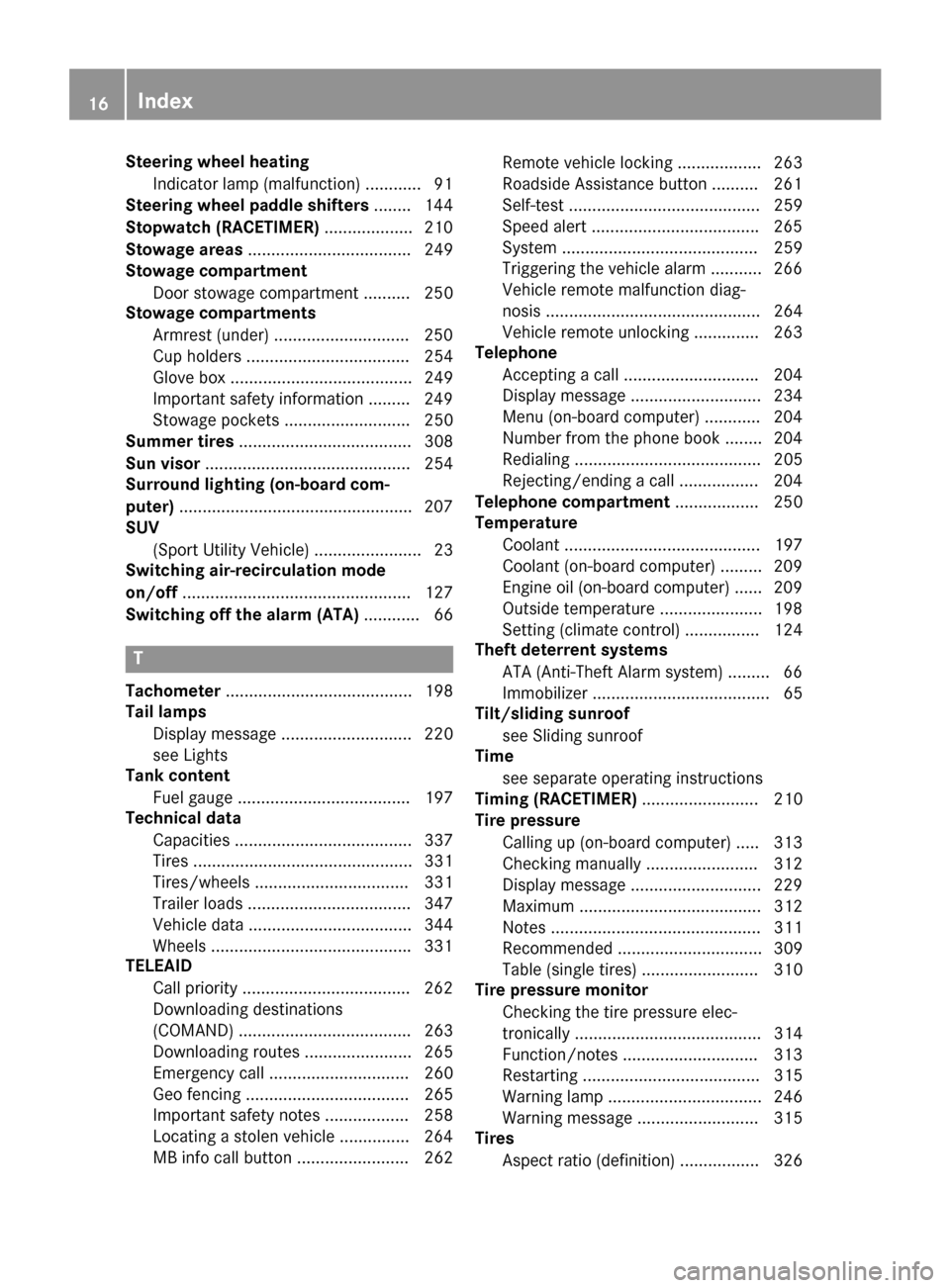
Steering wheel heating
Indicator lamp (malfunction) ............ 91
Steering wheel paddle shifters ........ 144
Stopwatch (RACETIMER) ...................210
Stowage areas ................................... 249
Stowage compartment
Door stowage compartment .......... 250
Stowage compartments
Armrest (under) ............................ .250
Cup holders ................................... 254
Glove box ....................................... 249
Important safety information ......... 249
Stowage pockets ........................... 250
Summer tires ..................................... 308
Sun visor ............................................ 254
Surround lighting (on-board com-
puter) ................................................. .207
SUV
(Sport Utility Vehicle) ....................... 23
Switching air-recirculation mode
on/off ................................................. 127
Switching off the alarm (ATA) ............ 66T
Tachometer ........................................ 198
Tail lamps
Display message ............................ 220
see Lights
Tank content
Fuel gauge ..................................... 197
Technical data
Capacities ...................................... 337
Tires ............................................... 331
Tires/wheels ................................. 331
Trailer loads ................................... 347
Vehicle data ................................... 344
Wheels .......................................... .331
TELEAID
Call priority ................................... .262
Downloading destinations
(COMAND) ..................................... 263
Downloading routes ....................... 265
Emergency call .............................. 260
Geo fencing ................................... 265
Important safety notes .................. 258
Locating a stolen vehicle .............. .264
MB info call button ........................ 262 Remote vehicle locking .................. 263
Roadside Assistance button .......... 261
Self-test ......................................... 259
Speed alert ...................................
.265
System .......................................... 259
Triggering the vehicle alarm ........... 266
Vehicle remote malfunction diag-
nosis .............................................. 264
Vehicle remote unlocking .............. 263
Telephone
Accepting a call ............................ .204
Display message ............................ 234
Menu (on-board computer) ............ 204
Number from the phone book ....... .204
Redialing ........................................ 205
Rejecting/ending a call ................. 204
Telephone compartment .................. 250
Temperature
Coolant .......................................... 197
Coolant (on-board computer) ......... 209
Engine oil (on-board computer) ...... 209
Outside temperature ..................... .198
Setting (climate control) ................ 124
Theft deterrent systems
ATA (Anti-Theft Alarm system) ......... 66
Immobilizer ...................................... 65
Tilt/sliding sunroof
see Sliding sunroof
Time
see separate operating instructions
Timing (RACETIMER) ......................... 210
Tire pressure
Calling up (on-board computer) ..... 313
Checking manually ........................ 312
Display message ............................ 229
Maximum ....................................... 312
Notes ............................................. 311
Recommended ............................... 309
Table (single tires) ......................... 310
Tire pressure monitor
Checking the tire pressure elec-
tronically ........................................ 314
Function/notes ............................ .313
Restarting ...................................... 315
Warning lamp ................................. 246
Warning message .......................... 315
Tires
Aspect ratio (definition) ................. 326 16
Index
Page 285 of 350
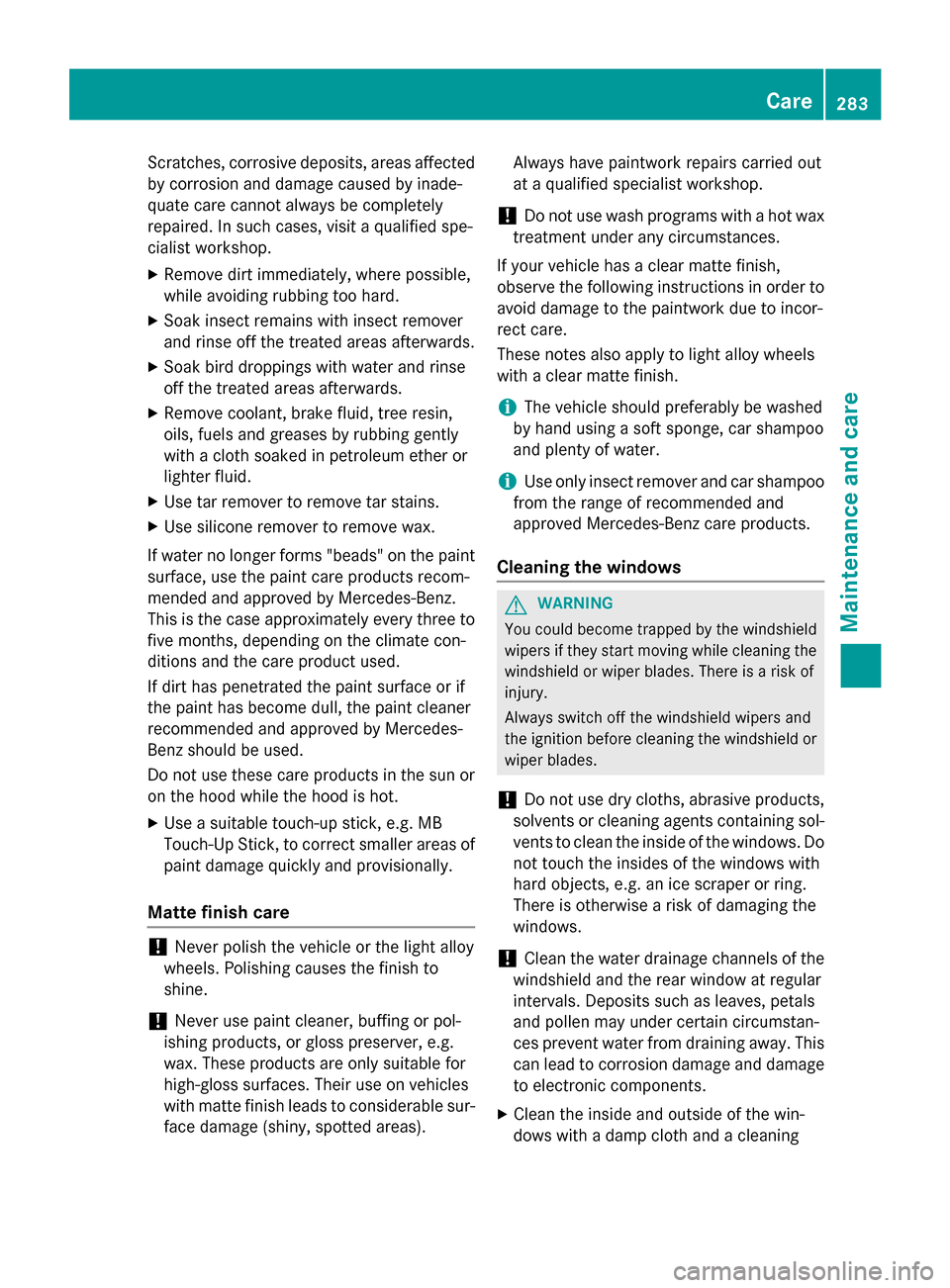
Scratches, corrosive deposits, areas affected
by corrosion and damage caused by inade-
quate care cannot always be completely
repaired. In such cases, visit a qualified spe-
cialist workshop.
X Remove dirt immediately, where possible,
while avoiding rubbing too hard.
X Soak insect remains with insect remover
and rinse off the treated areas afterwards.
X Soak bird droppings with water and rinse
off the treated areas afterwards.
X Remove coolant, brake fluid, tree resin,
oils, fuels and greases by rubbing gently
with a cloth soaked in petroleum ether or
lighter fluid.
X Use tar remover to remove tar stains.
X Use silicone remover to remove wax.
If water no longer forms "beads" on the paint
surface, use the paint care products recom-
mended and approved by Mercedes-Benz.
This is the case approximately every three to
five months, depending on the climate con-
ditions and the care product used.
If dirt has penetrated the paint surface or if
the paint has become dull, the paint cleaner
recommended and approved by Mercedes-
Benz should be used.
Do not use these care products in the sun or
on the hood while the hood is hot.
X Use a suitable touch-up stick, e.g. MB
Touch-Up Stick, to correct smaller areas of
paint damage quickly and provisionally.
Matte finish care !
Never polish the vehicle or the light alloy
wheels. Polishing causes the finish to
shine.
! Never use paint cleaner, buffing or pol-
ishing products, or gloss preserver, e.g.
wax. These products are only suitable for
high-gloss surfaces. Their use on vehicles
with matte finish leads to considerable sur- face damage (shiny, spotted areas). Always have paintwork repairs carried out
at a qualified specialist workshop.
! Do not use wash programs with a hot wax
treatment under any circumstances.
If your vehicle has a clear matte finish,
observe the following instructions in order to
avoid damage to the paintwork due to incor-
rect care.
These notes also apply to light alloy wheels
with a clear matte finish.
i The vehicle should preferably be washed
by hand using a soft sponge, car shampoo
and plenty of water.
i Use only insect remover and car shampoo
from the range of recommended and
approved Mercedes-Benz care products.
Cleaning the windows G
WARNING
You could become trapped by the windshield wipers if they start moving while cleaning the
windshield or wiper blades. There is a risk of
injury.
Always switch off the windshield wipers and
the ignition before cleaning the windshield or
wiper blades.
! Do not use dry cloths, abrasive products,
solvents or cleaning agents containing sol- vents to clean the inside of the windows. Do
not touch the insides of the windows with
hard objects, e.g. an ice scraper or ring.
There is otherwise a risk of damaging the
windows.
! Clean the water drainage channels of the
windshield and the rear window at regular
intervals. Deposits such as leaves, petals
and pollen may under certain circumstan-
ces prevent water from draining away. This
can lead to corrosion damage and damage to electronic components.
X Clean the inside and outside of the win-
dows with a damp cloth and a cleaning Care
283Maintenance and care Z
Page 288 of 350
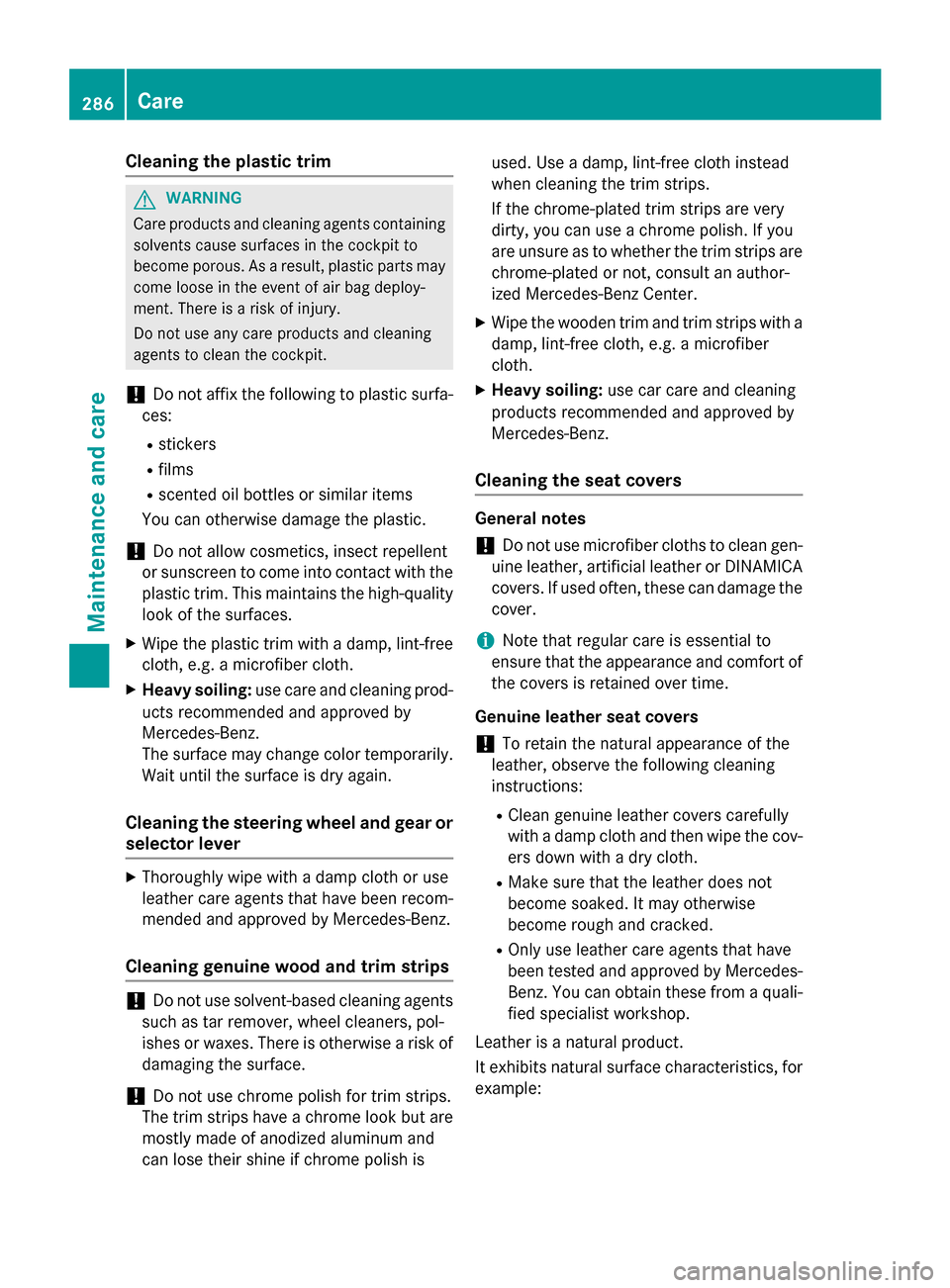
Cleaning the plastic trim
G
WARNING
Care products and cleaning agents containing solvents cause surfaces in the cockpit to
become porous. As a result, plastic parts may
come loose in the event of air bag deploy-
ment. There is a risk of injury.
Do not use any care products and cleaning
agents to clean the cockpit.
! Do not affix the following to plastic surfa-
ces:
R stickers
R films
R scented oil bottles or similar items
You can otherwise damage the plastic.
! Do not allow cosmetics, insect repellent
or sunscreen to come into contact with the
plastic trim. This maintains the high-quality look of the surfaces.
X Wipe the plastic trim with a damp, lint-free
cloth, e.g. a microfiber cloth.
X Heavy soiling: use care and cleaning prod-
ucts recommended and approved by
Mercedes-Benz.
The surface may change color temporarily.
Wait until the surface is dry again.
Cleaning the steering wheel and gear or selector lever X
Thoroughly wipe with a damp cloth or use
leather care agents that have been recom-
mended and approved by Mercedes-Benz.
Cleaning genuine wood and trim strips !
Do not use solvent-based cleaning agents
such as tar remover, wheel cleaners, pol-
ishes or waxes. There is otherwise a risk of
damaging the surface.
! Do not use chrome polish for trim strips.
The trim strips have a chrome look but are
mostly made of anodized aluminum and
can lose their shine if chrome polish is used. Use a damp, lint-free cloth instead
when cleaning the trim strips.
If the chrome-plated trim strips are very
dirty, you can use a chrome polish. If you
are unsure as to whether the trim strips are
chrome-plated or not, consult an author-
ized Mercedes-Benz Center.
X Wipe the wooden trim and trim strips with a
damp, lint-free cloth, e.g. a microfiber
cloth.
X Heavy soiling: use car care and cleaning
products recommended and approved by
Mercedes-Benz.
Cleaning the seat covers General notes
! Do not use microfiber cloths to clean gen-
uine leather, artificial leather or DINAMICA
covers. If used often, these can damage the cover.
i Note that regular care is essential to
ensure that the appearance and comfort of the covers is retained over time.
Genuine leather seat covers
! To retain the natural appearance of the
leather, observe the following cleaning
instructions:
R Clean genuine leather covers carefully
with a damp cloth and then wipe the cov-
ers down with a dry cloth.
R Make sure that the leather does not
become soaked. It may otherwise
become rough and cracked.
R Only use leather care agents that have
been tested and approved by Mercedes-
Benz. You can obtain these from a quali- fied specialist workshop.
Leather is a natural product.
It exhibits natural surface characteristics, for
example: 286
CareMaintenance and care
Page 342 of 350
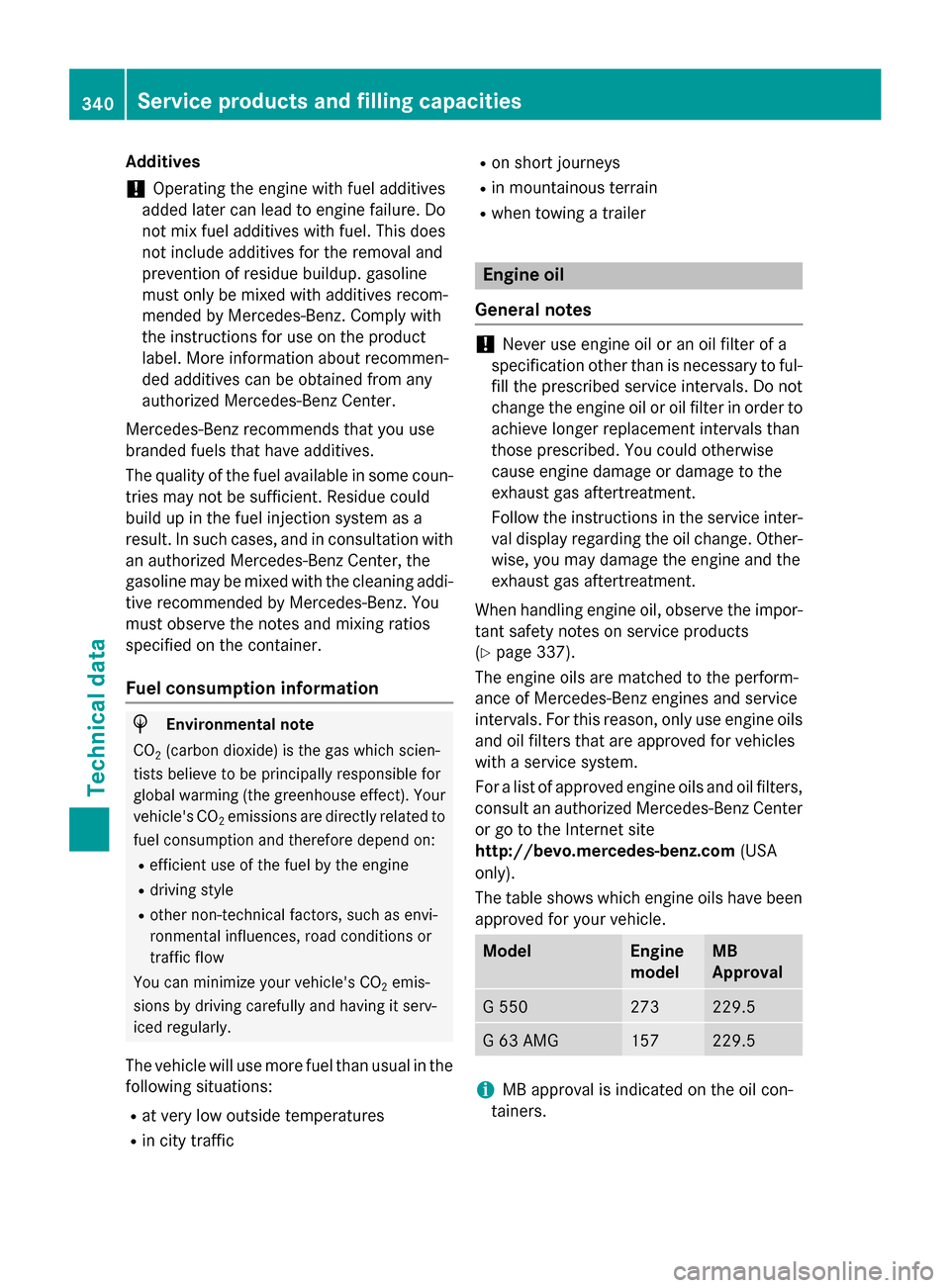
Additives
! Operating the engine with fuel additives
added later can lead to engine failure. Do
not mix fuel additives with fuel. This does
not include additives for the removal and
prevention of residue buildup. gasoline
must only be mixed with additives recom-
mended by Mercedes-Benz. Comply with
the instructions for use on the product
label. More information about recommen-
ded additives can be obtained from any
authorized Mercedes-Benz Center.
Mercedes-Benz recommends that you use
branded fuels that have additives.
The quality of the fuel available in some coun- tries may not be sufficient. Residue could
build up in the fuel injection system as a
result. In such cases, and in consultation with
an authorized Mercedes-Benz Center, the
gasoline may be mixed with the cleaning addi-
tive recommended by Mercedes-Benz. You
must observe the notes and mixing ratios
specified on the container.
Fuel consumption information H
Environmental note
CO 2(carbon dioxide) is the gas which scien-
tists believe to be principally responsible for
global warming (the greenhouse effect). Your
vehicle's CO 2emissions are directly related to
fuel consumption and therefore depend on:
R efficient use of the fuel by the engine
R driving style
R other non-technical factors, such as envi-
ronmental influences, road conditions or
traffic flow
You can minimize your vehicle's CO 2emis-
sions by driving carefully and having it serv-
iced regularly.
The vehicle will use more fuel than usual in the following situations:
R at very low outside temperatures
R in city traffic R
on short journeys
R in mountainous terrain
R when towing a trailer Engine oil
General notes !
Never use engine oil or an oil filter of a
specification other than is necessary to ful-
fill the prescribed service intervals. Do not
change the engine oil or oil filter in order to achieve longer replacement intervals than
those prescribed. You could otherwise
cause engine damage or damage to the
exhaust gas aftertreatment.
Follow the instructions in the service inter-
val display regarding the oil change. Other-
wise, you may damage the engine and the
exhaust gas aftertreatment.
When handling engine oil, observe the impor- tant safety notes on service products
(Y page 337).
The engine oils are matched to the perform-
ance of Mercedes-Benz engines and service
intervals. For this reason, only use engine oils and oil filters that are approved for vehicles
with a service system.
For a list of approved engine oils and oil filters,
consult an authorized Mercedes-Benz Center
or go to the Internet site
http://bevo.mercedes-benz.com (USA
only).
The table shows which engine oils have been
approved for your vehicle. Model Engine
model MB
Approval
G 550 273 229.5
G 63 AMG 157 229.5
i
MB approval is indicated on the oil con-
tainers. 340
Service products and filling capacitiesTechnical data
Page 343 of 350
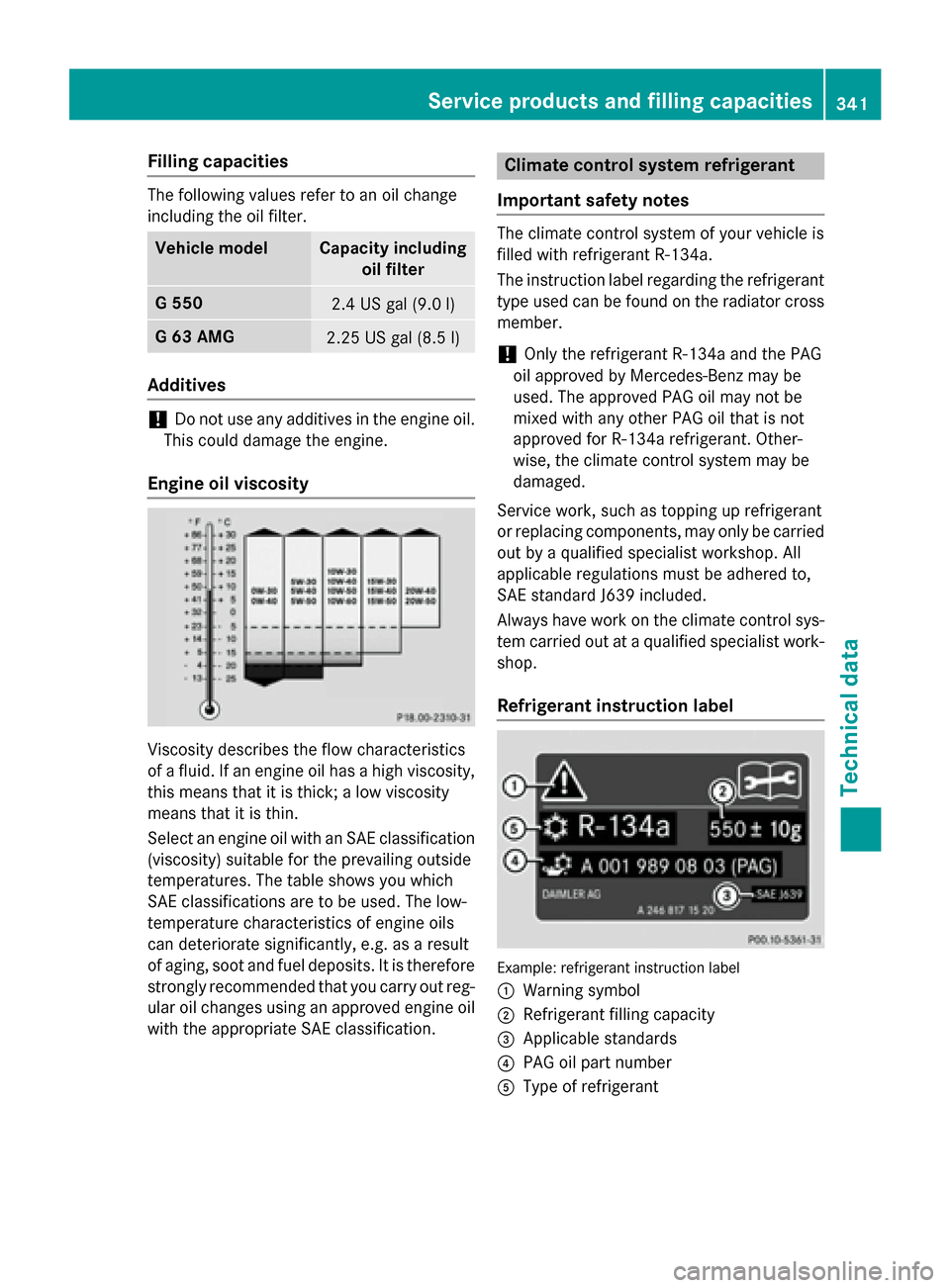
Filling capacities
The following values refer to an oil change
including the oil filter. Vehicle model Capacity including
oil filter G 550
2.4 US gal (9.0 l)
G 63 AMG
2.25 US gal (8.5 l)
Additives
!
Do not use any additives in the engine oil.
This could damage the engine.
Engine oil viscosity Viscosity describes the flow characteristics
of a fluid. If an engine oil has a high viscosity, this means that it is thick; a low viscosity
means that it is thin.
Select an engine oil with an SAE classification (viscosity) suitable for the prevailing outside
temperatures. The table shows you which
SAE classifications are to be used. The low-
temperature characteristics of engine oils
can deteriorate significantly, e.g. as a result
of aging, soot and fuel deposits. It is therefore
strongly recommended that you carry out reg- ular oil changes using an approved engine oil
with the appropriate SAE classification. Climate control system refrigerant
Important safety notes The climate control system of your vehicle is
filled with refrigerant R‑
134a.
The instruction label regarding the refrigerant type used can be found on the radiator cross
member.
! Only the refrigerant R‑134a and the PAG
oil approved by Mercedes-Benz may be
used. The approved PAG oil may not be
mixed with any other PAG oil that is not
approved for R-134a refrigerant. Other-
wise, the climate control system may be
damaged.
Service work, such as topping up refrigerant
or replacing components, may only be carried out by a qualified specialist workshop. All
applicable regulations must be adhered to,
SAE standard J639 included.
Always have work on the climate control sys-
tem carried out at a qualified specialist work-
shop.
Refrigerant instruction label Example: refrigerant instruction label
:
Warning symbol
; Refrigerant filling capacity
= Applicable standards
? PAG oil part number
A Type of refrigerant Service products and filling capacities
341Technical data Z